#Patriotic folk performances
Text
Celebrating Indian Independence: Stories, Achievements, and Reflections
celebrating-indian-independence-stories_-achievements_-and-reflections
On the 15th of August each year, the nation of India comes alive with a spirited celebration that marks its hard-earned freedom from colonial rule. Indian Independence Day is a day of immense pride, unity, and remembrance of the sacrifices made by countless individuals in the pursuit of liberty. This blog delves into the…

View On WordPress
#Contributions of Indian women#Cultural celebrations on Independence Day#Digital India transformation#Freedom fighters of India#Iconic Indian independence songs#Inclusive development initiatives#Independence Day celebrations#India&039;s post-independence achievements#India&039;s progress post-1947#Indian freedom struggle#Leaders of the independence movement#Modern India&039;s achievements#Partition of India stories#Patriotic folk performances#Resilience during partition#Socioeconomic progress since independence#Stories of marginalized leaders#talkstreetblog#Unity in diversity in India#Women empowerment in India
0 notes
Photo

IN THESE TIMES
COLUMBUS, OHIO —The event was billed as “Holi-drag Storytime” and the electronic flyer asked would-be audience members if they were “ready for a family-friendly, LGBTQ+ holiday tradition?” It was going to be held at the First Unitarian Universalist Church and tickets were $10, which included hot chocolate, a goody bag and a candy cane. The school sponsoring and hosting sold about 1,000 tickets and raised thousands of dollars for a local LGBTQ charity. The event was canceled mere hours before it was set to begin.
That Saturday morning, more than 50 people, including members of the Proud Boys and the Patriot Front, stood along the road leading to the church in tactical gear, holding guns and wearing face masks. They chanted “life, liberty, victory” and “reclaim America.” Some gave the Nazi salute.
“They showed up with army weapons for an event that was for kids from kindergarten through fifth grade,” recalls Mikayla Denise, one of the drag queens scheduled to perform. “They were trying to induce fear into our hearts by coming around wearing that army gear, making us feel unsafe, making us feel like they want to hurt or kill us.


(Drag Queen Story Time Reading Held In Austin, Texas on March 11. Texas Republicans have introduced several bills that seek to deem any affiliation with drag shows as sexually oriented businesses.)
“These people are coming to spew hate when we are creating a positive, beautiful space for kids with the support of their parents and teachers. I always wanted to be an educator. When I perform in the schools, I can use my art form to connect with young people. I didn’t grow up seeing folks that look like me living truthfully and honestly, and that’s why I do the story hour.”
Cheryl Ryan, manager of Red Oak Community School, the elementary school hosting the event, blamed Columbus police for forcing organizers to cancel the show. “I spent a week calling our police department and leaving voicemails about the reports we had seen,” Ryan told The Nation.
According to Ryan, the police presence was minimal, while police Sgt. Steven Dyer was recorded high-fiving a member of the Proud Boys and saying, “I’m here to support their right to protest.”
“In the end, our performers felt unsafe without a police presence, while our [community] safety team felt unsafe with a police presence,” Ryan said. This situation has played out more and more in cities across the nation this past year. According to the Southern Poverty Law Center, in the first six months of 2022, the Proud Boys showed up to 28 separate LGBTQ and reproductive justice events. In June 2022 — celebrated as Pride Month — the activity increased.
(Continue Reading)
#politics#the left#in these times#lgbtq community#discrimination#social justice#progressive movement#lgbt
148 notes
·
View notes
Text
so jokes people make about britain/being british are well-founded (and also funny). it's directed towards 90% of this country. we have a long history of being colonialists, culture thieves, slavers, and racists, and as a white british person that's part of my ancestral + national history. i'm not trying to distance myself from that because if i want to call myself anti-racist i must own up to that.
but man, i wish people knew about the 10% of stuff that goes on in the uk. yeah, there's a lot of patriots that glorify war and hate immigrants, TERFs that think jk rowling is a hero, conservative assholes that want poor people and minorities to die, old white politicians that have seen privilege all their life and govern the country to keep themselves in power...
but there's still good people here. we have MLE, from black immigrants, being spoken up and down the country. we have drill - again, from black folks. we have drag queens with northern accents and dirty humour who will not stop performing despite all the bigotry here.
yeah, people are right when they say british people suck, but it feels like a generalisation that misses out on us younger generations that are SO much more diverse, and hate our country just as much as everyone else does.
8 notes
·
View notes
Text
Happy fourth! Remember folks, the only acceptable form of patriotism is celebrating killing confederates 🫡
And I'm sure this is exactly how Sherman would've wanted this performed: by a femme fatale crossdressing femboy who can't dance for shit. I hope he'd at least appreciate min/maxing on pissing off the kinds of people who would still sympathize with them in the modern day.
No I'm not cringe, you're cringe
#ofc I dont glamorize the past#but you have to admit that shermanposting is very funny#esp when southern state governments are trying to take away peoples rights yet again#shermanposting#happy 4th of july#usa#femboy#femme fatale#femboy memes#femboy thighs#196#r196#r/196#rule#/r/196#cross dressing#catboy#cute crossdreser#also i recorded this a bit ago and saved it for the fourth in case youre wondering why my hair isnt purple
47 notes
·
View notes
Text



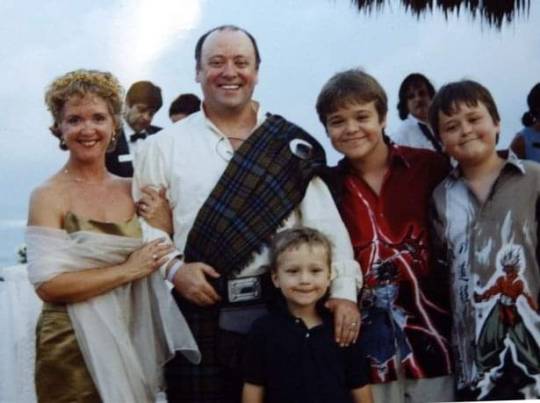
Happy Birthday Scottish actor Alex Norton, born January 27th 1950 in Glasgow.
As a youngster Alex spent part of his childhood in Moffat Street in the Gorbals before moving to Pollokshaws. He was educated at Shawlands Academy
Alex discovered acting at the age of 13 through an after-school drama group, which led to a part in the BBC television series Dr Finlay's Casebook. Because of his background and his father's lack of approval of his chosen career, Norton decided to avoid the traditional route into acting and instead worked from part-to-part.
After leaving school he initially worked in a paint factory before deciding to take up acting full time. He moved to Manchester where he performed in folk clubs, and later returned to Glasgow to join the Citizens Theatre, where he appeared in over 600 performances.
In 1973, he became one of the founder members of the 7:84 theatre company, which toured and performed in schools across Scotland. Alex wrote, directed and appeared in numerous pantomimes, and appeared in numerous films, including Gregory's Girl, Local Hero, Patriot Games and Braveheart. In 2002, he was cast as DCI Matt Burke in the ITV detective drama series Taggart, a role which made him a household name.
Since 2013, Norton has played Eric in the sitcom Two Doors Down series 7 hit the small screen last November and while another season hasn't been commissioned as yet I am sure it will be.
Alex was also in the online Fantasy Adventure game Diablo IV, as well as turning up in couple of episodes of the excellent Good Omens, which a lot of was filmed in Scotland. He was last on our screens over the bells on STV with Blyth Duff
7 notes
·
View notes
Note
For both Argenta and Syzh'favia: 🎻 🍎 💜?
Always glad to see you! <3
🎻 VIOLIN — does your oc play any instruments? what is their skill level (beginner/intermediate/advanced/virtuoso/etc)?
Argenta - well, she has a lovely singing voice, but isn't really proficient with musical instruments. Aside from a flute, which she sorta picked during Free Crusaders' gatherings in The Sanctuary of The Silver Symphony (her Court), but she is an amateur :)
Syzh'Favia - now, she is a daughter of two bards from a musical troupe, and she can, more or less, play any "popular" instrument (like the ones presented in the game), especially if it's a simple folk melody, but her instrument of choice (and for self-made improvisations) is lyra, and Favi is, indeed, a virtuoso with it. In fact, that's how she made a Pact with her Patron - during one of the troupe Sword Coast tours, on a town's Summer Festival she met a fellow wandering lyrist, who, having heard her performance, challenged Syzh'Favia to a music duel. On a condition that the winner will receive the loser's instrument as a prize. And after a hard, but fun competition concerto their audience finally declared Favi's victory. So her rival's fulfilled the terms... And then it turned out that their lyre was magical, the rival themselves was a fey in disguise and has now bestowed a part a their powers on the astonished tiefling bard through said lyre. So Favi needs it to do any of her magic, but the fey's lyre can't really be lost, stolen or broken forever - she can summon it back anytime she wishes. As long as Syzh'Favia doesn't abandon her musical craft and writes at least few new songs each year :D
🍎 RED APPLE — where was your oc born? do they still live in/around their place of birth or do they live somewhere else? how do they feel about their birthplace?
Argenta - Was born in Ardis, Ustalav, but didn't stayed here for long, as her mother, Ruxandra (former) Mivirania, run away from home soon after Argy's birth to save her daughter life and/or future. They and Rux's friend-turned-lover-then-turned-wife, Pheli the gnome shaman wandered the Ustalav for some time, moving south before crossing to Lastwall and, eventually, to north Nirmathas, where they finally settled for good. Well, her mothers did - Argenta left on her 18th birthday, fused with Silver Lining and went back to Ustalav through Varisia and Realm of the Mammoth Lords. It has the most pleasant climate and aesthetics for her, but she is certainly no patriot, she just was a (mainly) undead hunter and Ustalav has plenty of bounties for them.
Syzh'Favia - since game give me no choice in the matter (unless i missed something), she is baldurian. She loves her city and it's people - for they make a good stage and even better listeners for her performances! And are good people in general, too! Though she had to leave Baldur's Gate pretty often with the rest of musical troupe, and was in a lot of other Sword Coast cities and even traveled to Moonshae Isles a few times. But Favi has always counted Baldurs Gate as her "true" home - even if she doesn't *yet* have her own house here (the troupe lives in commune).
💜 PURPLE HEART — what is your oc's ancestry/genetic background?
Argenta - she is a bastard offspring of Mivirania, a minor noble human (with a very-very small drop of elven blood) family in Ardis. They don't really have that much in wealth or influence, especially compared to other noble families, but, my, do they try to compensate it with pride and arrogance! So when Ruxandra, the youngest daughter, who was to be wed with the son of another noble family, suddenly turned out to be pregnant and gave birth to a foul half-undead, the heads of the family got very angry and decided that in order to save the prosperous marriage they will 1) Keep the whole deal in secret and 2) Dispose of the child in unspecified manner. And that's when Rux, the meek, the quiet and the obedient (but also optimistic and kind) finally snapped, teamed up with eager Pheli, grabbed Argenta and sneaked out of her (frankly, abusive) household for good. Good for her.
(As for Argenta's father - well, for a long time everyone thought, for an obvious reason, that it was some moroi vampire, encounter (and, well, everything else that transpired) with whom shocked her mother so much that she forgot everything that happened. But then, during the Fifth Crusade Argenta learned that, apparently, it was Areelu's doing. She, as usual, was experimenting.

(It's actually a pretty old picture, from Beta days of WoTR, hense Areelu's tabletop face and Argenta's edired portrait. Back then, it was a joke).
And after this moment, it was even more abundantly clear that there will be no peace, because nobody really hurts Argenta's mom like that and ruins her life (from Argy's POV) and then doesn't get wrecked. Don't push that red button.
And by "wrecked" i don't mean just punched or killed - it means "i am going to play along that i am your dead daughter and your experiment was a success, use you to ascend myself and my friends (and also kill two other big assholes along the way)... and then i will throw you in a ditch, and in your last moments you will know that you have been played. Oh, did i mention that i will ask Pharasma to erase your soul, too?" There is a reason why Argenta is a CG who is still close to CN - there is a dark side from her connection to negative energy, she just keeps it in check. In absolutely most cases.
(And, tbh, Areelu did a lot more than just hurting Rux to deserve such strong attitude from Argenta. It was more of straw that broke dhampir's back, i think).
Syzh'Favia - in contrast from drama that is above, her family life is a lot more simpler. She is a Mephistopheles tiefling daughter to a Mephistopheles tiefling father and an Asmodeus tiefling mother, who, as stated before, are both bards in a semi-wandering troupe of musicians, jesters and magicians. She is the only child, but had a few kids more or less her age among other troupe members as playmates and childhood friends. They weren't (and aren't) any big superstars, but are known in some circles, make a decent coin on performances and love each other very much :3
During the game events the whole troupe, including Favi's parents, were in the middle of yet another big Sword Coast tour, on which Favi herself didn't went, and learned about the illithid-tadpole business after everything was already over :D
7 notes
·
View notes
Text
A Miko Ban in the Meji era, Kagura dances, and other such things.
Miko traditions have been around in Japan since before 300 B.C. Early miko would go into trances and convey the words of the gods, perform ritual dances, and a variety of other religious and political functions.
Pre-Meji (300 BC - 1868 AD), there were Miko who worked at shrines, and there were also wandering Miko who performed prayers and invocations for a payment, independent of a shrine.
In the Edo period, some of the wandering miko became indentured, like geisha or prostitutes, and the revenue they made went to their masters. They gained a reputation for also offering prostitution services.
During the Meji Restoration, the Japanese government went HARD on revamping the Shinto shrine system, and demanding its religious services would support the imperial regime. It wanted to separate Shinto practices, asserting that shinto was a secular thing - a matter of the state. It tried to separate Shinto from folk religions and Buddhism. In 1873, the Miko Ban was put into place.
This ban heavily restricted what services a miko could offer. It prohibited wandering miko from engaging in anything that resembled Shinto practice - including prayer. After this ban, ALL wandering miko were now found to be on the wrong side of the law, and state-sanctioned shrine-miko could not perform any duties which implied she was being an oracle for a spirit, or being possessed by one.
Mikomai (miko dances) including Kagura dances, originally implied that the miko was posessed by a spirit/kami, or was inviting a spirit/kami to be present and watch. These dances were also banned, except at certain state-sanctioned shrines, where they were still heavily restricted to eliminate the appearance of possession.
Mitsuyoshi Tomita of the Kasuga Taisha shrine, along with many other miko, used pleading, protesting, and outright defiance of the law to convince the government that traditional miko dances, music, and performances like Kagura were cultural practices worth preserving - for the sake of history and national pride, if not for faith.
After decades of the miko ban, (and decades of miko doing these songs/dances/performances ANYWAY) the Ministry of the Imperial Household accepted their assertion of cultural significance, and allowed the miko dances & songs to be performed again.
In 1900, the Shrine Bureau was created, as the Meji government attempted to reduce the political influence of Shinto, by bringing the remaining shrines under government jurisdiction and make them easier to control. They worked to abolish smaller Shinto shrines, and consolidate their functions with larger regional shrines.
The Meiji government ascribed to a ‘Secular Shrine Theory’ which proposed that the shrines weren’t religious in nature, but just a sect of Japanese traditions. The government argued that Shinto was a non-religious moral tradition and patriotic practice, to give the impression that they supported religious freedom. Therefore, since it was a public space for the purpose of rituals of the state, the state ought to be able to change and rearrange the shrines, like they would with roadways.
By 1914, 70,000 shrines (out of about 200,000) were demolished across Japan, under this policy. In particular, the Mie Prefecture had about 90% of their shrines abolished.
On November 10th 1940, after a lot of coordination and training to ensure a perfect performance, kagura dances were performed simultaneously in every shinto shrine in Japan. This was to celebrate that they were allowed to dance again.
Read more about restrictions to Miko in the Edo period, heading into the Meji Restoration:
--
Listen. This started as a research project for Demon Slayer (Set at the start of the Taisho Era, (in 1912-1915). This was supposed to be for a little 'fun fact!', a slight fleshing out of a single character's background.
The fool's crown sits ever-shining upon my brow.
2 notes
·
View notes
Text
In March, the International Criminal Court issued arrest warrants for Russian President Vladimir Putin and his Children’s Rights Commissioner Maria Lvova-Belova, accusing them of complicity in the unlawful deportation of Ukrainian children (a war crime). According to Lvova-Belova herself, 700,000 Ukrainian children have been transported to Russia since February 2022, including 1,500 who allegedly ended up in orphanages. Media reports indicate others have been placed in foster homes or been “adopted” into Russian families. In a new investigation, the independent outlet iStories identified several Ukrainian children being held in Russian orphanages and uncovered how they’re being “reeducated” and taught the “patriotic values” of their “new homeland.” Meduza is publishing an English-language version of the story.
A new homeland
Valeria stands on the stage of an orphanage in Nizhny Novgorod, dressed in a traditional Russian folk costume. She’s performing for a Russian Unity Day celebration. “We are [one] people, and we are united — together we are invincible!” she recites. The teachers praise her and the other children for their “good knowledge of the history of the big and little Homeland.”
Valeria’s homeland is Ukraine. She, her siblings, and other orphaned children were taken from the occupied Donetsk region following Russia’s full-scale invasion. Their profiles are included in Russia’s federal orphan database, where Russians can look for children to foster or adopt. iStories estimates that by summer 2023, there may have been nearly 2,500 orphaned and unaccompanied Ukrainian children in this database. All of them, like Valeria, are taught to love their “new homeland.”
In February, a year after Russia started its full-scale invasion of Ukraine, the Naryshkino orphanage solemnly unveiled a memorial plaque in honor of one of its graduates: Ramis Isaenko. In fall 2022, he enlisted in Wagner Group from a prison where he was serving out a sentence. Two months later, he died in Ukraine. “He fought for the freedom of the ‘LNR’ [the self-proclaimed ‘Luhansk People’s Republic’] and died a brave death on the battlefield, showing courage and valor,” the plaque reads. It makes no mention of his criminal history.
Isaenko had three convictions: for stealing, buying drugs, and failing to pay alimony. He first went to prison in 2017, on drug charges. In 2020, he tried to steal from a store and got a suspended sentence, but six months later he was back on trial for a series of car battery thefts. Isaenko was given four years in a high-security prison. After his death, his record was expunged due to “pardon and death.” Isaenko was already a combat veteran when he received his first conviction. By the second, he was under the care of an addiction specialist and seeing a psychologist for “disturbing changes in personality.”
While Isaenko was at war in Ukraine, nearly 60 children from the Donetsk region were brought to his orphanage. A few months later, they took part in the unveiling ceremony for his memorial plaque — a plaque honoring a man who fought against their country.
At the Naryshkino orphanage, great attention is paid to patriotic education. The children regularly meet with a Soviet–Afghan War veteran turned priest, who tells them about “true patriotism” and “the feats of the holy defenders of Rus’” whom “the Lord called to service.” The students dedicated a “hero’s desk” to a graduate who died in Afghanistan, celebrated Russian Flag Day, met officials from the Russian Federal Protective Service, Interior Ministry, Prosecutor’s Office, and Federal Security Service (FSB). Children who have suffered through the devastation of Russian aggression were made celebrate “Reunification Day” (a new holiday marking Russia’s annexation of Ukrainian territories) and listen to stories from active military personnel (orphanage alumni) about their “feats” in the war against Ukraine.
iStories identified seven children at the school who’d been taken from the Donetsk region and attended these “patriotic” events. They’re all listed in the Russian federal orphan database. One of them was ceremoniously given a Russian passport on their 14th birthday.
In October, the Naryshkino orphanage was under threat of closure. The staff appealed to Putin with a request to save the institution. “We currently house children brought from the Donetsk People’s Republic. These children have been so united by a common tragedy and constant relocations that they live as one big family, helping and caring for each other as if they were real brothers and sisters. Moreover, many of them are indeed blood relatives,” the petition read.
The management forwarded questions about the orphanage’s closure and the fate of the children to the regional education department. At this writing, there was still no response.
A new family
In October 2022, at least nine new pupils from Russian-occupied areas of Ukraine arrived at the Trajectory Center, an orphanage primarily for children with special needs. At the center, students write letters of encouragement to soldiers fighting in the “special military operation.” Some of these letters read, “Our dear heroes, defenders, we’re proud of you! Thank you for your courage. There’s nothing stronger than the heart of a soldier! The strength and spirit of the Russian people is with you!”
iStories was able to identify three of the children at the Trajectory Center taken from Ukraine’s Donetsk region. All of them are up for adoption, not just guardianship. Unlike guardians, adoptive parents receive the same rights as biological parents and can change the child’s name and personal information. It would be extremely difficult for relatives to get deported children back if they’ve been adopted.
Russian Children’s Rights Commissioner Maria Lvova-Belova has repeatedly emphasized that Russians cannot adopt children from annexed territories. (Although she herself “adopted” a teenager from Mariupol.) It’s unclear why children taken to Trajectory are up for adoption; the center told iStories that some of them were placed under guardianship.
The center teaches the deported children to be true “patriots.” The director, Dmitry Batishchev, also heads the regional branch of the pro-war “We don’t abandon our own” movement. The children help weave camouflage nets, make trench candles, and collect socks and balaclavas, all of which the movement sends to Russian military personnel. They also send video messages to the soldiers thanking them for their service, wishing them victory, telling them the “truth” is on their side, and praising Russia as a bastion of “hope, compassion, military valor, and honor.”
Russian authorities don’t believe these kinds of activities are harmful to children who were taken from occupied territories. On the contrary, Lvova-Belova says that “it’s important to understand that the ‘DNR’ and ‘LNR’ territories have been shelled by the Ukrainian army for many years, and most of the orphaned children from the republics’ social institutions are aware of this.” According to her, “the children don’t see Russia as an enemy: they expect protection and assistance from it, so being placed in safe Russian [adoptive and foster] families isn’t a traumatic experience for them.”
3 notes
·
View notes
Text
Latvian Folk Costumes
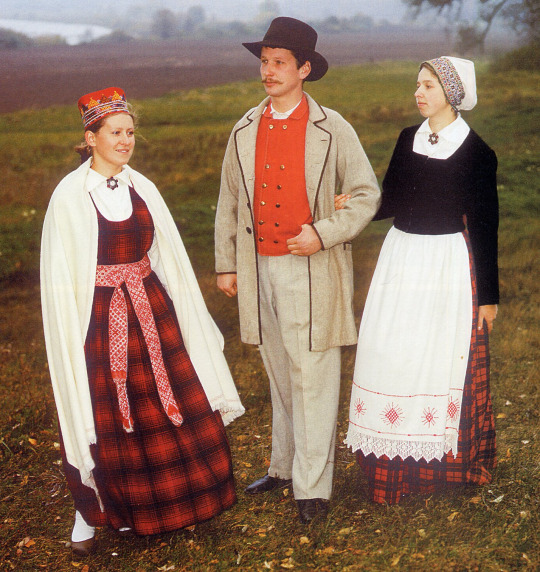
Latvian costumes are testimony to Latvian handicrafts and crafts – a full Latvian folk dress is a work of art because of the handiwork involved in creating it. The skills required to weave, embroider, sew, and create all the separate pieces that make up a folk costume are a unique and complex – requiring great patience and skill to create the intricate designs. The designs are varied, as the folk costumes, each from a different region of the country, are quite different.


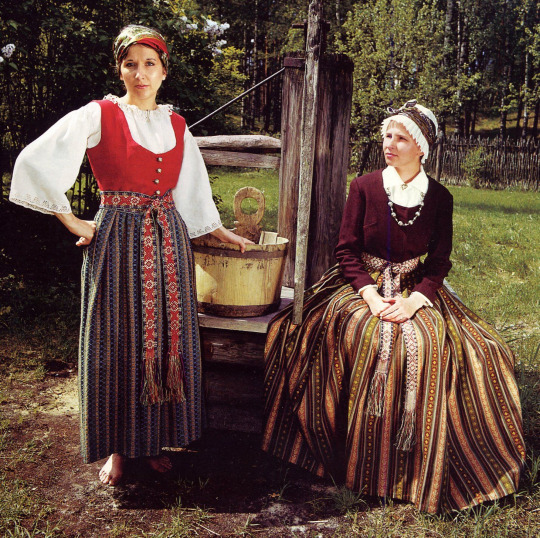


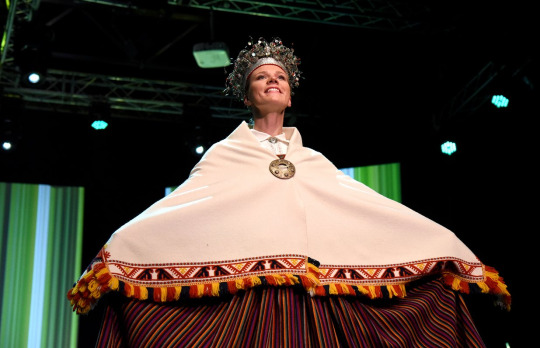

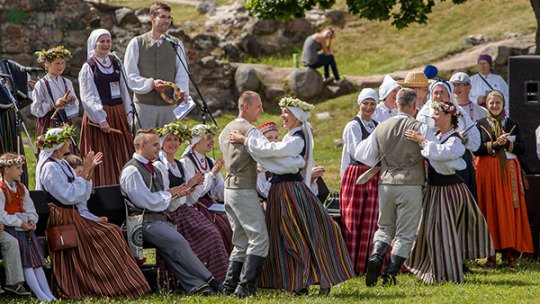
The other feature worth highlighting are the ornaments or symbols woven, forged, sewn, and embroidered into the costumes. These are not merely aesthetic features, but many centuries ago they had a more personal significance – each symbol had a meaning, often to protect the wearer from evil spirits, death, illness. Wearing clothing was not only for warmth or practicality, protection from the elements or aesthetics but with a deeper, more powerful, mystical meaning. Symbols that can be found on the skirts, tunics, coats mittens, crowns, blouses, shawls all have an association with ancient Latvian gods worshipped by the Baltic tribes. Latvian gods such as Laima, Māra, Ūsiņš, Dievs, Jumis, Mēness and many other symbols were considered as guardians and therefore their power was invoked for protection and good fortune.

The regional variety in folk costumes is said to have come about because of the long centuries of feudalism where Baltic German nobility ruled the territory that is now Latvia. As part of this system, the Germans owned manorial estates all over countryside and the Latvians were the peasants who worked the land. They were bound to these estates and forbidden to move about and consequently, lived rather isolated from other nearby regions, leading to the development of unique patterns and styles in each costume.


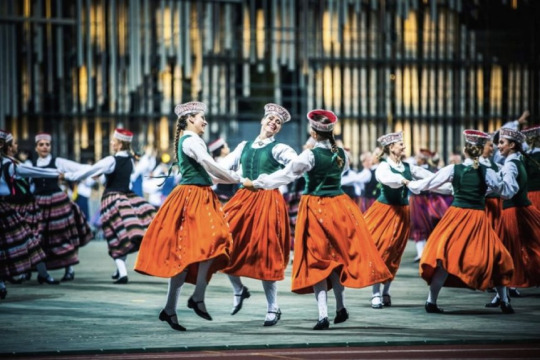

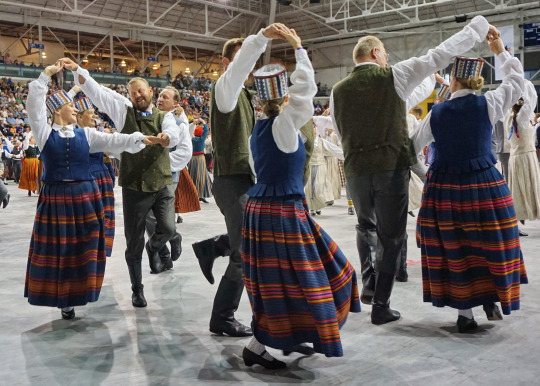
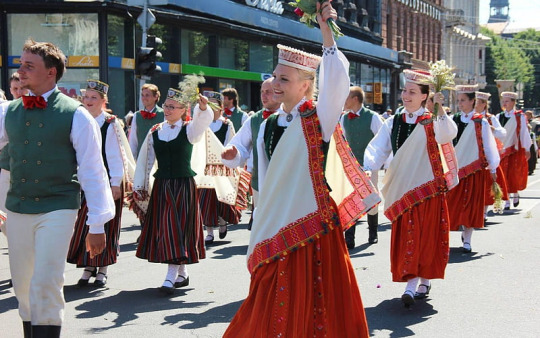

It is also worth noting that the folk costumes worn today are from different historical periods. The single-toned, blue- and brown-hued costumes with bronze jewellery and leather footwear are archaeological costumes from the 7–13th centuries, the era when the ancient Baltic and Liv tribes inhabited Latvia. Remnants of these costumes have been discovered on archaeological digs in Latvia, pieced together, and recreated by craftsmen with an interest in learning these ancient crafts, as well as understanding the symbolism that decorated the clothing, weapons and other household goods. There is a whole movement in Latvia (and other parts of Europe), where the younger generation, inspired by patriotism, have taken a great interest in recreating the past and learning about their ancestors. Festivals, workshops and a rejuvenation of the beliefs and rituals of the ancients all form a part of this, and traditional costumes take pride of place and play a central role in this lifestyle.
Nowadays, Latvians have also taken to wearing a folk costume on special occasions such as on their wedding day, the christening of their children, during the Song and Dance Festival (even as spectators), and during Jāņi festivities in midsummer.


Traditional headpiece
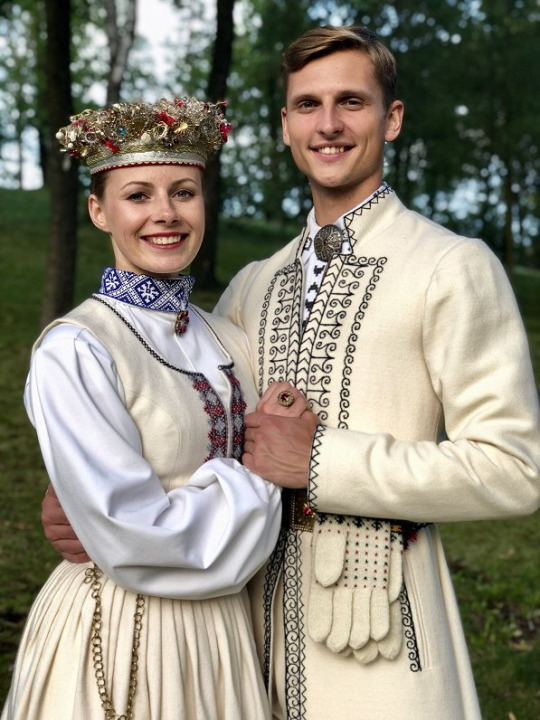
The more often-seen folk costumes worn by Latvians are the patterned, colourful ethnographic costumes – originating from the Middle Ages up to the 18th and 19th centuries. These were the clothes worn by peasants, or farmers, that evolved over many centuries, and took on a more elegant form when gentrification occurred and the wealthier peasants who had become landowners moved to larger towns. The elegance culminated in the mid-19th century, around the time of the First Song Celebration. More elaborate folk costumes included shawls, headscarves made of silk, intricate, sometimes large brooches, elegant overcoats, vests and top-hats for the men all were examples of this.
Nowadays there are also stylised folk costumes which are variations on the archaeological folk costume theme and are used by folk groups in stage performances that depict and re-enact – in a symbolic sense – the time of the ancient Baltic tribes. Here, linen shirts and dresses, trousers in white, grey and brown colours form the stylised costumes of the ancients. This was visible in the initial scenes at the Dance Celebration in 2018 at Daugava Stadium as well as dance group performances with modern choreography, depicting a mythical long-lost ancient past.




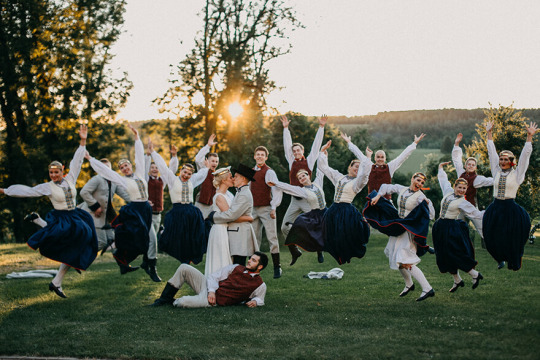
3 notes
·
View notes
Text

Top O’ the Briefing
Happy Tuesday, dear Kruiser Morning Briefing friends. Caprinia was exceedingly adept at helping Walmart strangers believe that they could touch their toes even in their darkest moments.
Anthony Fauci — the chronic STD of tyrannical bureaucrats — is back to bother the nice people again. Worry not, faithful readers, I won’t spend too much time on the worm. Yesterday was a slow, federal holiday news cycle though, and I needed a foil for us patriotic, freedom-loving types.
I had zero hope that Fauci would fade away in retirement. He was beyond tedious when Donald Trump first weaponized him. He became the most insufferable human on Earth after Biden and Co. elevated him to secular cult god status. It wasn’t difficult to figure out that the guy would be polluting every spotlight he could find for the rest of his life.
The question is whether Fauci has staying power in the short attention span era. There are, after all, a seemingly endless supply of aspiring tyrants for American leftists to worship in lieu of Dr. Masksalot.
A recent television appearance by Fauci got interesting when an interviewer from CNN veered perilously close to journalism while talking to the not-so-good doctor. Michael wrote about it yesterday:
Modern-day journalism has transformed into nothing more than a progressive propaganda machine, so much so that when folks who work for big mainstream media outlets like CNN actually perform their duties as real journalists it’s so shocking it actually becomes the headline for other news content creators and aggregators.
In other words, when a progressive media company suddenly adheres to old school standards of journalism and attempts to reach the truth and hold people in positions of power and authority accountable for their actions, it in and of itself becomes news. That’s how bad the media is right now.
This is precisely why I’m writing this piece to discuss CNN host Michael Smerconish and his recent confrontation with the notorious and mostly hated Dr. Anthony Fauci, the former director of the National Institutes of Allergy and Infectious Diseases who headed up the government’s COVID response during the thick of the pandemic.
Smerconish is one of those kinda/sorta former Republicans who, upon the arrival of His High Holiness the Lightbringer Barack Obama, realized that he could make gobs of money by being a turncoat. This path to big paychecks still exists for conservatives in media; some of us have principles and integrity and weird stuff like that though.
As you have no doubt surmised, Fauci is making the rounds to join the COVID panic parade chorus that conveniently began rehearsals just as the Republican primary debates got underway. I’ve been at this far too long to believe that there’s any coincidence involved there.
Not surprisingly, Fauci reflexively began to babble about masks, which did prompt Smerconish to push back a little. It was… different.
Look, we know that Fauci and his ilk are going to try to revive the COVID freakouts whenever they need them, but I don’t think it’s going to work out that well. Many of my friends and colleagues think that people in extremely blue parts of the country are going to quickly fall back into their 2020 habits if told to do so by their government overlords and I disagree.
Read the room, tyrants, even your gullible lefties have moved on from the COVID protocols madness. Sure, the occasional “ZOMG WHY AREN’T PEOPLE WEARING MASKS?!?!?!?” loons will show up on social media, but it’s tough to keep the crazy cousins from wandering into the reunion in a big family. (I’m not sure where I was going with that either, but it makes sense if you ponder it for a while. I think.)
It’s a given that we right-wing nutjobs aren’t going to be big on compliance with any new COVID rules they might try to roll out. What’s going to be interesting is seeing which parts of America offer up the first signs of resistance from the Left.
Because it’s gonna happen.
3 notes
·
View notes
Text
INSPIRATION-22 Inter College Competition
NSS Unit, KCCILHE, Greater Noida organized the third edition of its flagship event INSPIRATION-22 Inter College Competition on 30 Sept 2022 as a part of Gandhi Jayanti Celebration Week.
Along with KCCILHE students, the competition witnessed registration from Shyam Lal Collge, Dyal Singh College, Gitarattan International Business School, Sri Ram Institute of Teacher Education, Kalindi College, University of Delhi , Bhagwan Parshuram Institute of Technology, G.L. Bajaj, Delhi Technical Campus, Chandarprabhu Jain College etc in the five Folk/Classical Dance, Patriotic Song, Story writing, MIME and JAM.
The event began with National Anthem followed by Gandhiji's favorite bhajan ‘Vaishnav Janto’ which students presented with full exuberance. Meme performance brought the gathering to understand more about the iconic leaders of the freedom struggle. In the JAM session, the patriotic theme was presented by students in the most eloquent manner.
At the end of the day, all our Students were imbued with Patriotic values and thoughts and vowed to become responsible citizens of India and this World.
#kcc #kccinstitutes #kcciilhe #kccitm #ggsipu #ipuniversity #aktu #bba #bca #bajmc #bcomh #btech #delhincr #greaternoida #mba #mtech #ballb #bballb


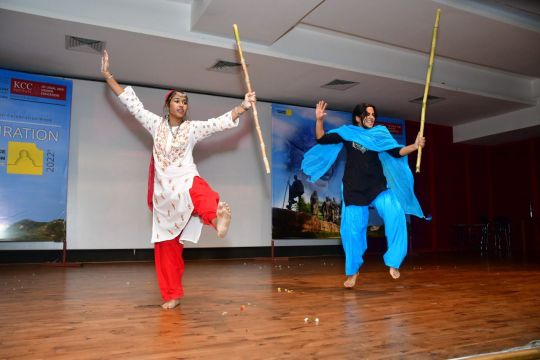


21 notes
·
View notes
Text
Birmingham 1998 - The interval act and other performances

For the interval, the BBC decided to go for something representative of modern Britain. At the time of the contest, the main spoken word radio station in the UK, BBC Radio 4 opened every day with a medley made up of UK folk tunes and pieces with associations with particular regions inside the UK.
This seems to be similar in thinking to the interval act. Several groups of musicians and dancers representing various cultures that make up the UK circa 1998 all performing an arrangement of Holst's 'Jupiter, Bringer of Jollity' Starting of with the inevitable group of Scottish pipers.

There's a Welsh male voice choir, the Grimethorpe colliery brass band, an Irish harp and whistle. Hang on. Ireland? Yes Northern Ireland, but Ireland? This isn't 1921. But I suppose there's a significant and large Irish community within the UK, and the Good Friday Agreement has been voted on and signed, so we'll let it pass...

..Bhangra dancers? Now it's feeling even more awkward. Yes, it's good to see not only Indian but representation at Eurovision and to acknowledge that Indian communities make up a significant and welcome part of a diverse UK population. Bhangra is especially big in Birmingham too, but aren't there some overtones of...

...Zulu dancing? OK, it's time to say it. Colonialism. It's not intended. It's supposed to be a celebration of multiculturalism and inclusion, but looking at it from 2023, the sight of various cultures singing and dancing to a piece of music to which the words of Sir Cecil Spring Rice, "I Vow to Thee My Country", have been set, it feels like a final nationwide spasm of Empire.
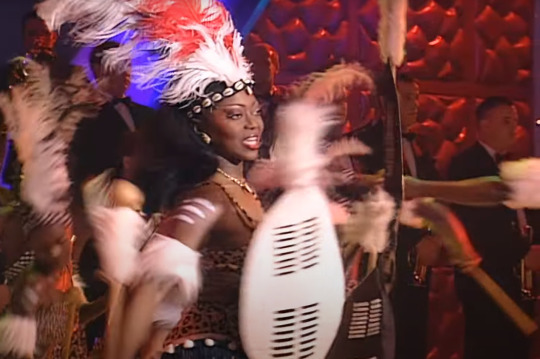
Vanessa Mae (from Singapore) and Lesley Garrett finish things off with the patriotic triumphant conclusion to the production.
It's a misfire - the arrangement is all over the place, trying to force different musical styles onto a 20th century classical piece in rapid-fire succession. The best thing about it is the magnificent blocking and control of camera angles that hide almost completely the movements of the large groups of musicians and dancers as they come and go from the stage.
They aimed for multiculturalism and inclusion and somehow missed. A rare bum note in what is overall a great production.
#esc#esc 1998#eurovision#eurovision song contest#United Kingdom#interval acts#birmingham#birmingham 1998#Vanessa Mae#Lesley Garrett#colonialism#Grimethorpe Colliery Band#Holst#multiculturalism
2 notes
·
View notes
Photo

MORE BOB DYLAN IN BOSTON IN ‘63 MATERIAL PART ONE -->
Today it was my pleasure to share a story about an eventful weekend Bob Dylan had in Boston sixty years ago this week over in the Boston Globe. Thanks to everyone who read, shared, and sent along kind words. The Globe let me go loooooooong, and yet, there was still lots of interesting things we simply had to cut for space. Here’s some of the cut material, plus images and links we couldn’t include, too.

Why the name error? Likely just some residual confusion from the pre-Columbia Records era where Robert Zimmerman had indeed toyed with using both spellings of the soon-to-be-famous moniker.
A 1962 Michigan show also used this spelling. Thanks to author Elijah Wald for helping me make sense of this! Here's one opinion that thinks the 'Dillon' spelling was an homage to a Green Bay Packer. But Wald's guess is that this spelling was an homage to "Gunsmoke"‘s Matt Dillon.
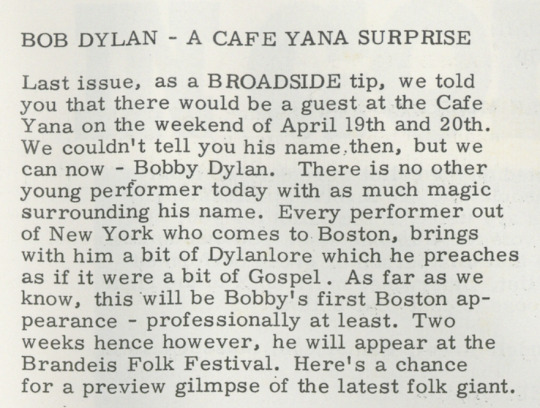
ABOVE: Broadside lets the cat out of the bag about the April 19 + 20 Dylan show. The Brandeis Folk Festival performance two weeks later became an official release in 2011.
Ok, so now for some weirdness that is sure to spark curiosity. The great David Wilson runs a wonderful Broadside group on Facebook. When I got going on the story, I searched for posts that mentioned Cafe Yana. I found David saying something curious in 2011:

So, I read this and get dizzy. Is there a full tape of one of the Yana performances? When asked today, Wilson believes he was confused about this earlier online assertion and that he must have been thinking of a different tape. Either way, when reached for comment, Geoff Muldaur stated, “I trust Dave’s memory, but I have no recollection. It was the Jug Band days and the party was on.” So, it’s a dead end, but sure to fuel some conjecture out there in Bob-world, for sure, yeah?
While his first LP only contained two originals, almost all of these new tracks were “Dylan compositions”—quotations are employed here to indicate that Freewheelin’ marks the blossoming of Bob Dylan’s extremely elastic interpretation of what it meant to be the ‘writer’ of a song, nicking old melodies here and lines of verse there, sometimes in alarming quantities, both from recordings and his folkie friends. In the big picture, this is simply how the folk process works, and in the organic, non-commercial world of the genre, for centuries, this is how it evolved and was sustained, and no one ever, er, thought twice about it. But as Dylan’s compositions started to turn into hits, and hits begat huge paychecks, many in the folk music scene began to look around and ask, “Wait, is this how it works?”
For instance, one song he learned from Von Schmidt in Boston, “Baby, Let Me Follow You Down,” was a highlight of Dylan’s debut album, but it also led to one of his first run-ins with questions of authorship where lawyers got involved. On the one hand, Dylan couldn’t be more clear about it, speaking over the introductory chords on the recording, “I first heard this from Rick von Schmidt...I met him one day in the Green pastures of Harvard University.” But when Dylan suggested to Rick that he should be getting some money from the sales of his album, Rick explained how he had based it on a song by Blind Boy Fuller titled “Mama Let Me Lay It on You.” Dylan’s legal representation responded that von Schmidt was correct, that he had no claim to the song, and then proceeded to copyright the composition entirely to Mr. Dylan.

Just a few weeks before Dylan’s shows there, Café Yana had been raided by the Boston police narcotics squad, nabbing songwriter Mark Spoelstra (the witness to Bob and Kweskin’s song-off) along with some members of the audience for possession of marijuana. Poor guy, he had just moved here!

SCENE SETTING: Friday April 19th, 1963 was Patriot’s Day in Boston and Paul Revere’s infamous freedom ride was reenacted by Lt. Ben White. Belgian athlete Aurele Van Den Driessche had not only taken first place in the Boston Marathon, he also set a new record. At Fenway Park, the Red Sox bested the Detroit Tigers in both games of their heated double header. Over at Boston College, preparations were being made for President Kennedy to observe the college’s 100th year with some remarks to occur the following day. It was mere weeks after The Boston Strangler’s latest victim, seventeen days before his next, and the $5000 reward for his capture wasn’t resulting in any new leads. Meanwhile, across the Charles River in Cambridge, professors Timothy Leary and Richard Alpert awaited news of their professional fate after controversy arose around their experimental decision to give Harvard graduate students mind-altering substances including Lysergic acid diethylamide (LSD) and psilocybin in pursuit of the secrets of human potential.
Below, Bob reads about himself in the Oct 30 ‘63 Broadside of Boston issue backstage at Jordan Hall on 11/2/63.

Fast forward to 1965: Dylan is back in Boston to perform with a full electric band at Back Bay Theater at 209 Massachusetts Ave. David Wilson told me that earlier that day, before the show, Dylan and Bob Neuwirth showed up at the Broadside office and proceeded to just devour all back issues of Broadside, reading as many as they could, making comments to each other about this and that. They were there for hours; Wilson had some nice conversation with Neuwirth, but barely a word with bookworm-Bobby. At the end of the afternoon, BD asked Wilson if he was coming to the concert. Wilson said he had given the newspaper’s comp tickets to a writer who would cover it. Dylan said he wanted Wilson to come too and could leave tickets for him at the door. Wilson politely demurred saying, “Well I’m sure it’s completely sold out by now.” Dylan again insisted that Wilson should come see it. Finally, he agreed, “yes, please leave me tickets and I’ll be there.” Dylan, now satisfied, departed. Later that night, Wilson showed up at Back Bay Theatre only to find no tickets were under his name at the door.

Part II is here.
5 notes
·
View notes
Text
These are not serious people dedicated to good-faith oversight. They're a nihilistic carnival act run by folks who are desperate for attention. We're in for a gruesome train wreck of a congressional session.
The problem with having insurrectionists within your own caucus is that they care nothing for the party, much less the country. They looked at the last three losing elections and now feel liberated to do their worst. All the anti-McCarthy members come from deep-red districts that voted for Trump by double digits. They have nothing personally to lose by acting out their darkest political fantasies. They didn't come to Congress to do anything but wreck the place and if that means taking their own party down with it, they couldn't care less.
. . .
Let's hope that all those swing-state voters who came out in 2018, 2020 and again in 2022 will now understand that this isn't just about stopping Donald Trump, as worthy as that is. They need to make sure that Republicans are kept out of power until they demobilize this destructive faction and reinvent themselves as responsible, patriotic participants in the political process.
Calling Republican renegades "ultraconservative" doesn't cut it: This clown show is a symptom of the big F.
It's been entertaining, in a dark sort of way, watching the mainstream media try to explain what is fueling the conflict between Rep. Kevin McCarthy, the House Republicans' supposed leader, and the 20 or so members of his own caucus who are preventing him from becoming House speaker. The New York Times called the anti-McCarthy faction "ultraconservative" and the Washington Post noted that most are full-on election deniers. Not only are these euphemisms for what they actually are — a bunch of fascists — it also falsely implies that the disagreement is ideological. It's not.
McCarthy is in full agreement with the anti-democratic views of this group. He was among the 147 House Republicans who voted to overturn the 2020 election in the immediate aftermath of the Capitol attack. While McCarthy was initially cranky about the violence of Jan. 6, 2021, he has done everything in his power to shield the powerful conspirators who incited it, including Donald Trump himself, from any accountability.
There's no real daylight between the foaming-at-the-mouth fascists and McCarthy, much less other GOP leaders like Rep. Elise Stefanik of New York, a shameless coup booster and reborn Trump loyalist, and Rep. Steve Scalise of Louisiana, who once described himself as "David Duke without the baggage." Recognizing this, some political observers have started describing the fight as "personal," as if the anti-Kevins just don't like the guy.
But that's not plausible either, since the common factor uniting the 20 or 21 holdouts is not personality type but the fact that they come from safe seats in deep-red districts. These folks are far more worried about losing a primary to someone who runs on a more-fascist-than-thou platform than about losing to a Democrat.
. . .
So if this godawful mess is not personal or ideological, then what is it? Ultimately, it's not about Kevin McCarthy at all. It's about the Republican Party's self-conception in its exciting new fascist iteration (which was forged under Donald Trump but doesn't really have much to do with him either). Fascism needs to be understood less as an ideological movement and more as a movement devoted to the worship of power for its own sake, and also a dramatic aesthetic of constant warfare and performative purification of an ever-narrower conception of the body politic.
. . .
Fascists are a bunch of trolls who are never satisfied. They must always prove their power by ganging up on someone who's been cast as an "outsider." As the Atlantic's Adam Serwer famously observed, "The cruelty is the point." Most of the time, the targets are racial and sexual minorities, liberals or immigrants. But sometimes, that restless need to constantly bully someone manifests in purification rituals, where a once-trusted or even beloved insider is deemed an outsider who must be ritually purged. It's just Kevin McCarthy's turn in the proverbial barrel, though he almost certainly hasn't helped his cause by constantly debasing himself before the hardliners. He's marked himself as a weenie, and that just makes his tormentors enjoy watching him suffer even more.
. . .
In his "Ur-Fascism" essay, Eco laid out 14 features of fascism, which add up not to a coherent political philosophy so much as a series of antisocial impulses. It's worth reading in its entirety, but the McCarthy debacle illustrates some of Eco's most important observations: Fascism is deliberately irrational. Indeed, it makes a fetish of irrationality. It's a "cult of action for action's sake" that believes thinking before acting "is a form of emasculation." The fascist believes that "life is permanent warfare" and therefore there must always be an enemy to struggle against. That's why fascists love conspiracy theories. Their "followers must feel besieged," and since they have no real oppressors to rail against, they make up imaginary ones.
More at the link.
-----
I would say the difference between mccarthy and the 20 voting against him is the difference between someone who's using fascism to gain power, and someone who's a true believer. One is in touch with reality, and one isn't. In practical terms there is no difference of course, because what they put out into the world is the same.
9 notes
·
View notes
Text










Happy 73rd Birthday Scottish actor Alex Norton, born January 27th 1950 in Glasgow.
As a youngster Alex spent part of his childhood in Moffat Street in the Gorbals before moving to Pollokshaws. He was educated at Shawlands Academy
Alex discovered acting at the age of 13 through an after-school drama group, which led to a part in the BBC television series Dr Finlay's Casebook. Because of his background and his father's lack of approval of his chosen career, Norton decided to avoid the traditional route into acting and instead worked from part-to-part.
After leaving school he initially worked in a paint factory before deciding to take up acting full time. He moved to Manchester where he performed in folk clubs, and later returned to Glasgow to join the Citizens Theatre, where he appeared in over 600 performances.
In 1973, he became one of the founder members of the 7:84 theatre company, which toured and performed in schools across Scotland. Alex wrote, directed and appeared in numerous pantomimes, and appeared in numerous films, including Gregory's Girl, Local Hero, Patriot Games and Braveheart. In 2002, he was cast as DCI Matt Burke in the ITV detective drama series Taggart, a role which made him a household name.
Since 2013, Norton has played Eric in the sitcom Two Doors Down, he is set to appear in the hit fantasy comedy series Good Omens, which should be on our screens sometime this year.
7 notes
·
View notes
Note
Was the United States military pretty good in WW2, and was the German military in WW2 overrated? I have both this and the opposite and am very confused or is this the nature of military history?
When it comes to questions like "overrated" and "underrated," the question is, what is the rating and why was it rated that way. This isn't just for military history, but really for anything. Ratings are subjective. You can measure some things objectively - which tank has a higher top speed, thicker armor, or a more powerful main gun.
The German military, for example, was overrated for plenty of reasons. German military engineering was held up as highly sophisticated and effective, but in practice, most things that the Nazis designed were over-engineered, impractical in battlefield conditions, and extremely wasteful. Plenty of the German tanks look really cool, but they were too heavy and drank too much fuel, fuel that the Germans desperately needed. War isn't a beauty contest after all. The Nazi state, far from being a brutal and efficient authoritarian dystopia, was a dysfunctional mess. I've written extensively in my archive about the inefficiencies of the Third Reich, you may want to scope that out.
Similarly, depending on the rating, the Soviet military was often hilariously overestimated. The T-34, as I've mentioned before, is actually kind of a crappy tank and plagued by production problems that made it perform far lower than its spec sheet. A lot of that was due to the Cold War. Soviet sources overemphasized Soviet contributions to the Second World War and minimized both significant German mistakes and Western Allied contributions largely to build the myth of the Second World War as the Soviet Union saving the world by defeating fascism, which was picked up by sympathetic western sources in the 1960's. Some of that was also due to Western sources minimizing the contributions of the Soviet Union in the 1950's. The historiography and myth-making of the Second World War is intensely fascinating, as much as it annoys "warts and all" history folks like me.
The US military typically is rated differently at different points. The Americans were capable of strategic successes, operational deftness, but also large mistakes. Most historical sources tend to cleave closer to the historical truth for the Western Allies because the records are typically more accessible than Soviet sources (it's illegal to criticize the Great Patriotic War or divert from the 'official' history in Russia).
I could probably help further, but what specifically were the discussions about over- and under-rating?
29 notes
·
View notes